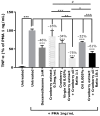Cranberry Oil: A Potent Natural Intimate Care Ingredient Displaying Antioxidant and Anti-Inflammatory Effects and Promoting Beneficial Vaginal Lactobacillus
- PMID: 40076798
- PMCID: PMC11899961
- DOI: 10.3390/ijms26052176
Cranberry Oil: A Potent Natural Intimate Care Ingredient Displaying Antioxidant and Anti-Inflammatory Effects and Promoting Beneficial Vaginal Lactobacillus
Abstract
Cranberry oil is known for nutritional benefits, and this work is aimed at studying its soothing properties and potential as an intimate care ingredient. The antioxidant, anti-inflammatory, and anti-irritation properties of cranberry oil were evaluated on epithelial cells and tissues, including the vaginal epithelium. The impact of the oil on vaginal microbiota was assessed in vitro. Cranberry oil reduced oxidative stress in keratinocytes (ROS -43%) and lowered inflammation by lessening the release of cytokines IL-8 (-33%) and TNF-α (-32%). Irritation induced by sodium dodecyl sulfate (SDS) in skin explants was lowered by 24%. Cranberry oil and fruit extract acted synergistically on inflammation, decreasing TNF-α release by 75% (vs. -34% and -16%, respectively). Cranberry oil reduced inflammation on EpiVaginal™ tissue, decreasing IL-6 by 36%. The minimum inhibitory concentration (MIC) of cranberry oil on the pathogenic vaginal microorganisms C. albicans and G. vaginalis was 0.5% and 0.1%, respectively. The oil promoted the growth of commensal L. jensenii (×79 at 0.1%) and favored a high proportion of lactic acid bacteria when co-cultured with C. albicans. Cranberry oil has antioxidant, anti-inflammatory, and soothing properties on skin. Anti-inflammatory activity was confirmed on vaginal epithelium, and initial in vitro evidence indicates that the oil can balance vaginal flora to prevent dysbiosis.
Keywords: Candida albicans; Gardnerella vaginalis; Lactobacillus; Vaccinium macrocarpon; cranberry; epithelium; fatty acids; intimate care; keratinocytes; skin; vaginal flora.
Conflict of interest statement
Authors Cloé Boira, Julia Jolibois, Anaïs Durduret, Caroline Szewezyk, Morgane De Tollenaere, Amandine Scandolera, and Romain Reynaud are employed by the company Givaudan Active Beauty. The remaining author declares that the research was conducted in the absence of any commercial or financial relationships that could be construed as a potential conflict of interest.
Figures









Similar articles
-
Dietary cranberry suppressed colonic inflammation and alleviated gut microbiota dysbiosis in dextran sodium sulfate-treated mice.Food Funct. 2019 Oct 16;10(10):6331-6341. doi: 10.1039/c9fo01537j. Food Funct. 2019. PMID: 31524900 Free PMC article.
-
Tetraglochin andina Ciald.: A medicinal plant from the Argentinean highlands with potential use in vaginal candidiasis.J Ethnopharmacol. 2018 Apr 24;216:283-294. doi: 10.1016/j.jep.2018.01.001. Epub 2018 Jan 4. J Ethnopharmacol. 2018. PMID: 29307753
-
Synergistic Inhibition of Candida albicans by Cranberry Proanthocyanidins and Probiotics: Novel Strategies for Vulvovaginal Candidiasis Treatment.Pathogens. 2025 Mar 24;14(4):308. doi: 10.3390/pathogens14040308. Pathogens. 2025. PMID: 40333065 Free PMC article.
-
Cranberry proanthocyanidins: natural weapons against periodontal diseases.J Agric Food Chem. 2012 Jun 13;60(23):5728-35. doi: 10.1021/jf203304v. Epub 2011 Nov 29. J Agric Food Chem. 2012. PMID: 22082264 Review.
-
Cranberry: Chemical Composition, Antioxidant Activity and Impact on Human Health: Overview.Molecules. 2022 Feb 23;27(5):1503. doi: 10.3390/molecules27051503. Molecules. 2022. PMID: 35268605 Free PMC article. Review.
Cited by
-
Comparative Physicochemical and Pharmacotechnical Evaluation of Three Topical Gel-Cream Formulations.Gels. 2025 Jul 9;11(7):532. doi: 10.3390/gels11070532. Gels. 2025. PMID: 40710694 Free PMC article.
References
-
- Sedbare R., Raudone L., Zvikas V., Viskelis J., Liaudanskas M., Janulis V. Development and Validation of the UPLC-DAD Methodology for the Detection of Triterpenoids and Phytosterols in Fruit Samples of Vaccinium Macrocarpon Aiton and Vaccinium oxycoccos L. Molecules. 2022;27:4403. doi: 10.3390/molecules27144403. - DOI - PMC - PubMed
-
- Šedbarė R., Janulis V., Pavilonis A., Petrikaite V. Comparative In Vitro Study: Assessing Phytochemical, Antioxidant, Antimicrobial, and Anticancer Properties of Vaccinium Macrocarpon Aiton and Vaccinium oxycoccos L. Fruit Extracts. Pharmaceutics. 2024;16:735. doi: 10.3390/pharmaceutics16060735. - DOI - PMC - PubMed
MeSH terms
Substances
LinkOut - more resources
Full Text Sources
Medical
Molecular Biology Databases

